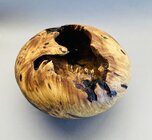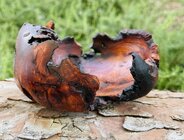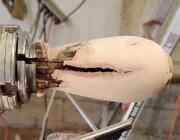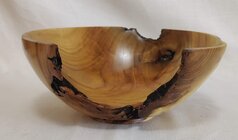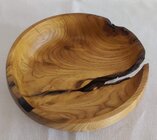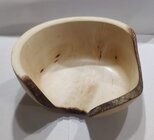John Jordan famously (is said to have) said, Life's too short to turn crappy wood." I find myself turning challenging, arguably crappy wood often, especially burls and spalted material. I like oddball pieces with voids and wild grain and I hate to give up on a piece once I have some work in it, but I sure do spend an inordinate amount of time dealing with pieces that get smaller and smaller or give me the yips as checks open and close during the turning and drying process. What's your tolerance for crappy wood?
-
December 2025 Turning Challenge: Single Tree! (click here for details) -
Congratulations to Bob Henrickson, People's Choice in the November 2025 Turning Challenge (click here for details) -
Congratulations to Steven Gordon for "Dropped Ice Cream Cone" being selected as Turning of the Week for December 8, 2025 (click here for details) -
Welcome new registering member. Your username must be your real First and Last name (for example: John Doe). "Screen names" and "handles" are not allowed and your registration will be deleted if you don't use your real name. Also, do not use all caps nor all lower case.
You are using an out of date browser. It may not display this or other websites correctly.
You should upgrade or use an alternative browser.
You should upgrade or use an alternative browser.
turning "crappy wood"
- Thread starter Kevin Jenness
- Start date
- Joined
- Apr 27, 2004
- Messages
- 9,304
- Likes
- 6,058
- Location
- Lakeland, Florida
- Website
- www.hockenberywoodturning.com
For ordinary wood that is past its use by date - I have two tests it must passWhat's your tolerance for crappy wood?
1. It has to be structurally safe to turn and hard enough that I can’t easily push a flat screw driver into it.
2. I have to have a concept of it becoming a piece I will be pleased with.
For wood with historical or sentimental significance - I’ll try to make something that can be treasured.
ZERO Exceptions - What Hockenbery said
I think Hockenbery summed it up. Voids and cracks are cool—I just don’t want them in my head.
I have a particular distain for cracked wood. I like to think I do some nicely finished and detailed work. I don't want anyone to think I like broken wood, or don't know how to dry it. None of my artist friends sell any of their ceramic or glass work that has a huge crack in it, I don't either. Secondly, distractingly bright colored plastic has no place in something from Mother Nature.
I guess I'm in the middle. I make mostly useful stuff, so solid wood is most appropriate. I don't mind bark inclusions or voids in some pieces that will be more decorative, but I don't seek them out. When I get real wonky pieces of fresh wood, I give them to my friend who loves them for the challenge and novelty, as he makes entirely decorative pieces.
When I was early in the journey, I would try to repair and salvage wood with defects or problems that arose while turning. I don't do that any more, as it's just too much work to glue and fill, and maybe get a decent result. That's where I think John Jordan's expression applies.
When I was early in the journey, I would try to repair and salvage wood with defects or problems that arose while turning. I don't do that any more, as it's just too much work to glue and fill, and maybe get a decent result. That's where I think John Jordan's expression applies.
Last edited:
Donna Banfield
TOTW Team
I agree with everything the above commentators have posted. I admit, in my early days, I spent/wasted time trying to salvage a piece, that never should have been on the lathe.
That said, two things are relevant in my journey as a Woodturner: I am definitely averse to putting anything on the lathe that may bite back at me. Equally as important, the journey I have taken requires specific species of wood, without voids or cracks. When I encounter those issues when turning they are quickly removed and replaced. The discarded wood heats my home 18 months later.
That said, two things are relevant in my journey as a Woodturner: I am definitely averse to putting anything on the lathe that may bite back at me. Equally as important, the journey I have taken requires specific species of wood, without voids or cracks. When I encounter those issues when turning they are quickly removed and replaced. The discarded wood heats my home 18 months later.
Woodturning is a collaboration between the maker (you) and the material (wood). It should be an enjoyable process, and if the material is terrible to begin with, then it isn't. Simple enough, as John Jordan alluded to.
One can also look at this in a competitive sense: hopefully you "win" most of the time, but sometimes the wood "wins," meaning no matter how hard and long you try, you end up with something that doesn't deserve shelf space (even in a closet).
But, ok, say you do confront all the hardships, difficulties and challenges that a bad piece of wood presents, and you manage to complete a piece in some form. Later, as you look at it, is the recollection of its making enjoyable, or does it only elicit agony of all the time you spent making it...not to mention looking ugly? As Jordan said, "Life is too short."
Remind yourself that there are two parts to woodturning: the process, and the resultant work. Enjoy both equally, IMPO.
One can also look at this in a competitive sense: hopefully you "win" most of the time, but sometimes the wood "wins," meaning no matter how hard and long you try, you end up with something that doesn't deserve shelf space (even in a closet).
But, ok, say you do confront all the hardships, difficulties and challenges that a bad piece of wood presents, and you manage to complete a piece in some form. Later, as you look at it, is the recollection of its making enjoyable, or does it only elicit agony of all the time you spent making it...not to mention looking ugly? As Jordan said, "Life is too short."
Remind yourself that there are two parts to woodturning: the process, and the resultant work. Enjoy both equally, IMPO.
My view is more "Life's too short to turn boring wood". John usually made a lot of carvings to enhance his works, so was perhaps not so dependant on interesting wood. Usually, I go for wood that has interesting grain, but also spalted wood, occasionally with cracks glued together with epoxy. In any case you have to take care of avoiding problems. Example with interesting grain in rowan and spalted oak with epoxy in cracks.
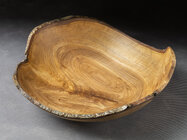
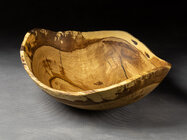
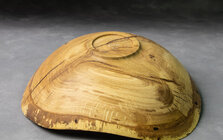



I like the challenge in some of the pieces of wood. I turn for me so I don't have to worry about production times or worries.
This piece of birch was so rotten I had to soak it in shellac numerous times as I turned it.
I posted it on Facebook and had 15 people offer to buy it in the first few minutes.
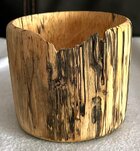
My latest piece was soft, rotten and in places dusty. Shellac and packing wrap held it together while I turned it.
I and others love how it came out. Again this one was posted on another site and got 40+ likes in the first day. With numerous offers to buy.
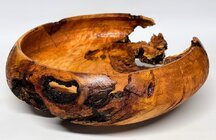
Depends on personal taste. As they say beauty is in the eye of the beholder.
This piece of birch was so rotten I had to soak it in shellac numerous times as I turned it.
I posted it on Facebook and had 15 people offer to buy it in the first few minutes.

My latest piece was soft, rotten and in places dusty. Shellac and packing wrap held it together while I turned it.
I and others love how it came out. Again this one was posted on another site and got 40+ likes in the first day. With numerous offers to buy.

Depends on personal taste. As they say beauty is in the eye of the beholder.
This really encapsulates the “hobby” for those of us who aren’t professionals. Great post.Woodturning is a collaboration between the maker (you) and the material (wood). It should be an enjoyable process, and if the material is terrible to begin with, then it isn't. Simple enough, as John Jordan alluded to.
One can also look at this in a competitive sense: hopefully you "win" most of the time, but sometimes the wood "wins," meaning no matter how hard and long you try, you end up with something that doesn't deserve shelf space (even in a closet).
But, ok, say you do confront all the hardships, difficulties and challenges that a bad piece of wood presents, and you manage to complete a piece in some form. Later, as you look at it, is the recollection of its making enjoyable, or does it only elicit agony of all the time you spent making it...not to mention looking ugly? As Jordan said, "Life is too short."
Remind yourself that there are two parts to woodturning: the process, and the resultant work. Enjoy both equally, IMPO.
My tolerance is low.
I don't turn much green wood, prefer dry. I cut a lot of blanks from green log sections and dry them. If certain cracks develop while drying I cut them away. I'd rather turn smaller, good blanks then larger cracked blanks. I do sometimes leave tight cracks I find on one end of a spindle or box blank where it might be held in compression in a chuck or cut away before turning.
I have no problem with punky areas in a large blank if the overall blank is good. Big wood with deep cracks, not for me.
What others do while turning doesn't matter to me, unless it's large and I can't move out of the way.
I don't turn much green wood, prefer dry. I cut a lot of blanks from green log sections and dry them. If certain cracks develop while drying I cut them away. I'd rather turn smaller, good blanks then larger cracked blanks. I do sometimes leave tight cracks I find on one end of a spindle or box blank where it might be held in compression in a chuck or cut away before turning.
I have no problem with punky areas in a large blank if the overall blank is good. Big wood with deep cracks, not for me.
What others do while turning doesn't matter to me, unless it's large and I can't move out of the way.
My turnings are intended to be in use every day. That means no crappy wood for me. That stuff goes into the wood stove. I frequently see pieces of wood at our club raffles that would go into my stove. Maybe a pro could turn them safely, but most in the club were never pro.
robo hippy
robo hippy
I often look for wood that is "crappy" so to speak. Wood, like most things in nature is not perfect. Some prefer to put out the perfect product and that is fine. My focus is on the visual experience of a piece and as long as you respect the wood, it doesn't bite. Here are a few of my pieces that otherwise would have become firewood.
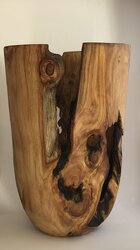
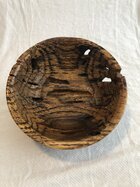
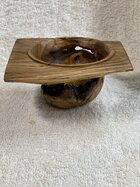
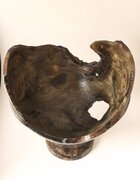




First, I find imperfect wood challenging, enjoyable and always marvel at what it wants to be. Does every piece come to fruition, no but that is part of the challenge. Second, to call such turnings "ugly" is of one's opinion. When looked at as an art form it depends on what the person looking at it sees and what it elicits. Art is in the eye of the beholder.Later, as you look at it, is the recollection of its making enjoyable, or does it only elicit agony of all the time you spent making it...not to mention looking ugly? As Jordan said, "Life is too short."
Remind yourself that there are two parts to woodturning: the process, and the resultant work. Enjoy both equally, IMPO.
All of the pieces that I posted above were sold as someone saw something in it. The first one I kept for my own collection.
- Joined
- Feb 28, 2021
- Messages
- 1,770
- Likes
- 1,582
- Location
- Roulette, PA
- Website
- www.reallyruralwoodworks.com
When I first started, and did not yet have a stash of roughed out bowls to work with, I turned every piece I could safely do so with.What's your tolerance for crappy wood?
However, nowadays after trying to save many pieces that either were already, or became, crappy wood, in the end the results were often not what I felt happy with (I'm no artist - don't have that eye that many of you seem to have for getting the best out of pieces like Lou and Alan pictured) so more and more I become more picky about what stuff I'll go on to turn , and for blanks, what I'll either turn into spindle blanks , or toss in the burn pile... so even if a piece of wood has great grain and figure or even beautiful flame, I am more likely to toss it than to try and save it. I'm more into Robo hippy's viewpoint than Lou or Alan's
Many write about trying to save crappy wood, perhaps that is what John originally meant. I don´t try to save it. I try to utilise it to make an interesting piece.
Dave Landers
Beta Tester
I agree with John “Life's too short to turn crappy wood."
But I doubt we would have agreed on a definition of “crappy”
But I doubt we would have agreed on a definition of “crappy”
I on the other hand have made it perhaps a career choice, to turn that which most reject and its been very successful and profitable for me. Ok this ball game is quite different and you have go at it differently, in the beginning I have had a few monumental cardio work outs. But these days its rare, its the challenge that gets me going and so often the finished piece is spectacular.
this is my kind of turning, love itHere’s my contribution. View attachment 74948View attachment 74949
- Joined
- Feb 6, 2010
- Messages
- 3,454
- Likes
- 2,522
- Location
- Brandon, MS
- Website
- threeringswoodshop.square.site
Have to agree with Dave we would have problems trying to define "Crappy Wood". That said I have had my share early on turning bad wood and making efforts to save a piece. But now recognize that bad stuff much better and besides have a shop full of other woods.
Here’s my contribution. View attachment 74948
this is my kind of turning, love it
Yes, that’s incredible. But life sure would be boring if we all did the same thing! I’m happy just to see and appreciate some of the amazing pieces posted here, in print, in galleries, craft fairs, and touch them at show-and-tell.
JKJ

